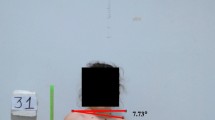Abstract
Background
Breast asymmetries and scoliosis influence the results of augmentation mammaplasty. Although a variety of methods have been proposed to resolve breast asymmetries, to date, no simple preoperative algorithm has been proposed for predicting the breast volume and decreasing breast asymmetries in the place of subjective or expensive evaluation. The relationship between the scoliosis and breast volume asymmetry was further analyzed statistically in this study.
Methods
The study enrolled 60 scoliotic patients from 780 patients undergoing augmentation mammaplasty between January 2000 and March 2008. The average follow-up period was 2 years. The inclusion criteria required hypoplastic breasts, a difference in bilateral breast volumes greater than 20 ml, and scoliosis with a Cobb angle greater than 10°. The authors’ surgical algorithm demonstrated an anthropomorphic equation for predicting breast volume and selecting the correct implant size.
Results
Pearson regression analysis showed that the breast volume asymmetry difference was significantly correlated with the severity of scoliosis (Cobb angle) (correlation coefficient, 0.901). No correlation between the difference in pre- and postoperative nipple and inframammary levels and the severity of scoliosis was noted. Augmentation mammaplasty significantly decreased the breast asymmetry differences (volume and nipple level) (p < 0.001). The average preoperative estimated breast volume was 45.3 ml for the smaller breast and 88.4 ml for the larger breast.
Conclusion
This study found that the severity of scoliosis showed significant correlation with the breast volume asymmetry differences. Augmentation mammaplasty for breast asymmetries decreased not only the volume difference but also the difference in nipple levels.







Similar content being viewed by others
References
Tebbetts JB (2001) The greatest myths in breast augmentation. Plast Reconstr Surg 107:1895
Rohrich RJ, Hartley W, Brown S (2003) Incidence of breast and chest wall asymmetry in breast augmentation: a retrospective analysis of 100 patients. Plast Reconstr Surg 111:1513–1519
Arlet V, Th Odent, Aebi M (2003) Congenital scoliosis. Eur Spine J 12:456–463
Korovessis P, Iliopoulos P, Koureas G, Zacharatos S, Stergiou P (2007) Evolution of anterior chest wall blood supply in female adolescents with progressive right-convex thoracic idiopathic scoliosis. J Spinal Disord Tech 20:190–194
Krapohl BD (2005) Functional evaluation of the spine in patients with breast hypertrophy. Plast Surg Nurs 25:187–189
Araco A, Gravante G, Araco F, Gentile P, Castri F, Delogu D, Filingeri V, Cervelli V (2006) Breast asymmetries: a brief review and our experience. Aesth Plast Surg 30:309–319
Denoel C, Aguirre MFI, Bianco G, Mahaudens PH, Vanwijck R, Garson S, Sinna R, Debrun A (2009) Idiopathic scoliosis and breast asymmetry. JPRAS 62:1303–1308
Wolfram D, Behensky H, Piza-Katzer H (2009) Unilateral giantomastia related to juvenile fibroadenoma with idiopathic thoracic scoliosis. J Pediatr Adolesc Gynecol 22:e25–e27
Kovacs L, Eder M, Hollweck R, Zimmermann A, Settles M, Schneider A, Endlich M, Mueller A, Schwenzer-Zimmerer K, Papadopulos NA, Biemer E (2007) Comparison between breast volume measurement using 3D surface imaging and classical techniques. Breast 16:137–145
Bulstrode N, Bellamy E, Shrotria S (2001) Breast volume assessment: comparing five different techniques. Breast 10:117–123
Qiao Q, Zhou G, Ling Y (1997) Breast volume measurement in young Chinese women and clinical applications. Aesth Plast Surg 21:362–368
Sun SP, Hsu KW, Chen JS (2009) Postoperative evaluation platform of female breast implant surgery with breast configuration indicator. Comput Biol Med 39:595–603
Hueston JT (1968) Surgical correction of breast asymmetry. Aust N Z J Surg 38:112–116
Elsahy NI (1976) Correction of asymmetries of the breasts. Plast Reconstr Surg 57:700
Marconi F, Gallucci A, Marra M (1994) Idiopathic unilateral hypoplasia of the breast. Minerva Chir 49:971–975
Edstrom LE, Robson MC, Wright JK (1977) A method for the evaluation of minor degrees of breast asymmetry. Plast Reconstr Surg 60:812–814
DeLuca-Pytell DM, Piazza RC, Holding JC, Snyder N, Hunsicker LM, Phillips LG (2005) The incidence of tuberous breast deformity in asymmetric and symmetric mammaplasty patients. Plast Reconstr Surg 116:1894–1899
McMaster MJ, Ohtsuka K (1982) The natural history of congenital scoliosis: a study of two hundred and fifty one patients. J Bone Joint Surg Am 64:1128–1147
Al-Sabounchi S, De Mey AMG, Eder H (2006) Textured saline-filled breast implants for augmentation mammaplasty: does overfilling prevent deflation? A long-term follow-up. Plast Reconstr Surg 118:215–222
Cunningham BL, Lokeh A, Gutowski KA (2000) Saline-filled breast implant safety and efficacy: a multicenter retrospective review. Plast Reconstr Surg 105:2143–2149
Hvilsom GB, Holmich LR, Henriksen TF, Lipworth L, McLaughlin JK, Friis S (2009) Local complications after cosmetic breast augmentation: results from the Danish registry for plastic surgery of the breast. Plast Reconstr Surg 124:919–925
Acknowledgment
This study was supported by Taipei Medical University (TMU) grant TMU98-AE1-B10.
Author information
Authors and Affiliations
Corresponding author
Rights and permissions
About this article
Cite this article
Tsai, FC., Hsieh, MS., Liao, CK. et al. Correlation Between Scoliosis and Breast Asymmetries in Women Undergoing Augmentation Mammaplasty. Aesth Plast Surg 34, 374–380 (2010). https://doi.org/10.1007/s00266-010-9506-x
Received:
Accepted:
Published:
Issue Date:
DOI: https://doi.org/10.1007/s00266-010-9506-x




